German Expressionism – Discover Some Traditional German Art
German Expressionism was one of the German art movements in the early 20th century that stressed the artist’s internal emotions or thoughts rather than imitating reality. German Expressionism paintings were distinguished by simple forms, vivid colors, and expressive gestures or brushwork. With the emergence of German Expressionism art, new principles in the production and evaluation of art were established. Today, we will explore how German Expressionism art steered away from traditional German art to create a new form of modern Expressionism.
Contents
- 1 German Expressionism Art
- 2 Notable German Expressionism Paintings
- 2.1 Hans Tietze and Erica Tietze-Conrat (1909) by Oskar Kokoschka
- 2.2 Large Blue Horses (1911) by Franz Marc
- 2.3 Blue-Black Fox (1911) by Franz Marc
- 2.4 Türkisches Café (1914) by August Macke
- 2.5 Portrait of a Man (1919) by Erich Heckel
- 2.6 Seated Girl (1920) by Ernst Ludwig Kirchner
- 2.7 The Widow I (1921) by Käthe Kollwitz
- 2.8 Fish Magic (1925) by Paul Klee
- 2.9 Breakfast of the Birds (1934) by Gabriele Münter
- 3 Frequently Asked Questions
German Expressionism Art
In which country did the Expressionist movement originate? Expressionist artists arose simultaneously in numerous towns around Germany in reaction to pervasive concerns over humanity’s progressively conflicting connection with the planet, as well as a sense of a lack of moral integrity and spiritual connection.
Expressionist artists created a potent method of social critique in their gestural depictions and use of bright colors as a result of their interaction and conflicts with the city life of the early 20th century.
German Expressionism Characteristics
20th-century German Expressionism art began in Germany in Munich and Dresden in the mid-1900s. At around the same period, a few related but smaller German art movements arose in Austria. In general, the German Expressionist movement continued as an artistic evolution of the Saxon Worpswede School and the Fauvist movement from Paris until the outbreak of World War I.
It was also inspired by Van Gogh’s early Expressionist works, such as Starry Night (1889)
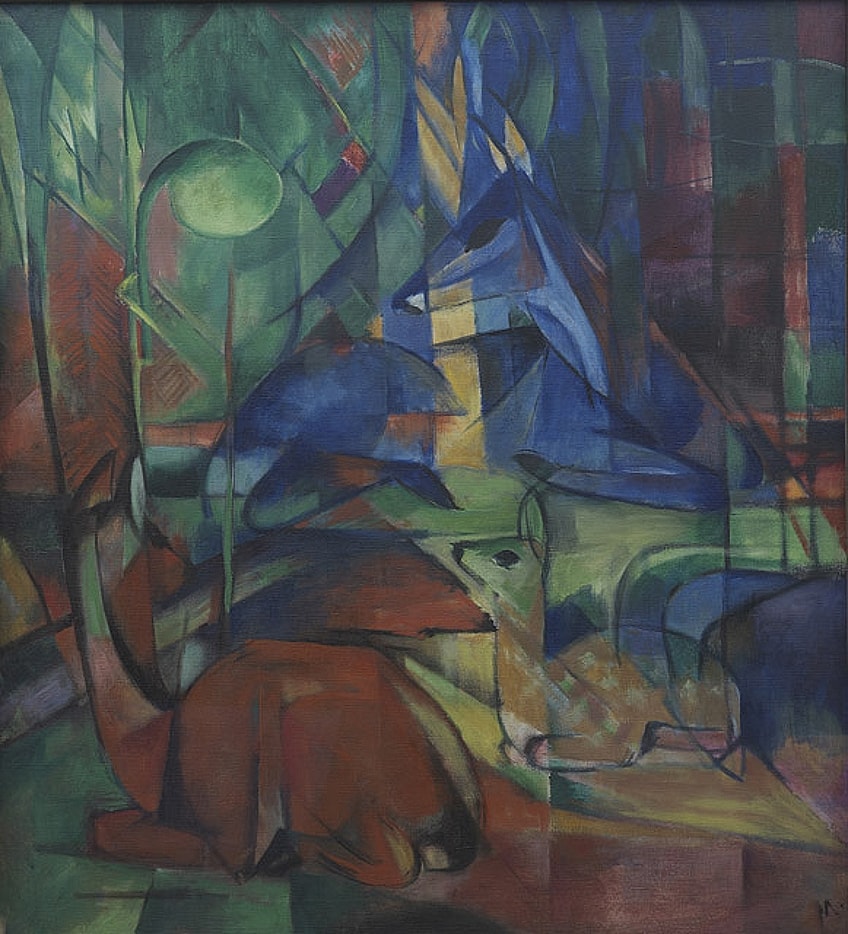
Contrary to the Impressionists, who only strove to mimic nature, German Expressionist artists frequently manipulated color, dimension, and space to portray their personal thoughts about what they observed. Nevertheless, conflict permanently damaged many of these artists.
As a consequence, beginning in 1915, German Expressionism art became both a vehement protest movement and a new art form. Sturm Gallery in Berlin was the epicenter of most of this avant-garde work.
Pioneers of German Expressionism Art
The fierce German religious artist Matthias Grunewald was maybe the first creator of German Expressionism paintings. Vincent Van Gogh exerted a significant effect on early Expressionists 350 years later. Another precursor was Edvard Munch, the best-known Scandinavian artist, whose artworks depicted his mental deterioration. The Worpswede Group, an artists’ community founded in 1889, the year before Van Gogh’s passing, was another predecessor.
It was named after a hamlet in Lower Saxony and included artists such as Otto Modersohn, Fritz Mackensen, and Hans Ende.
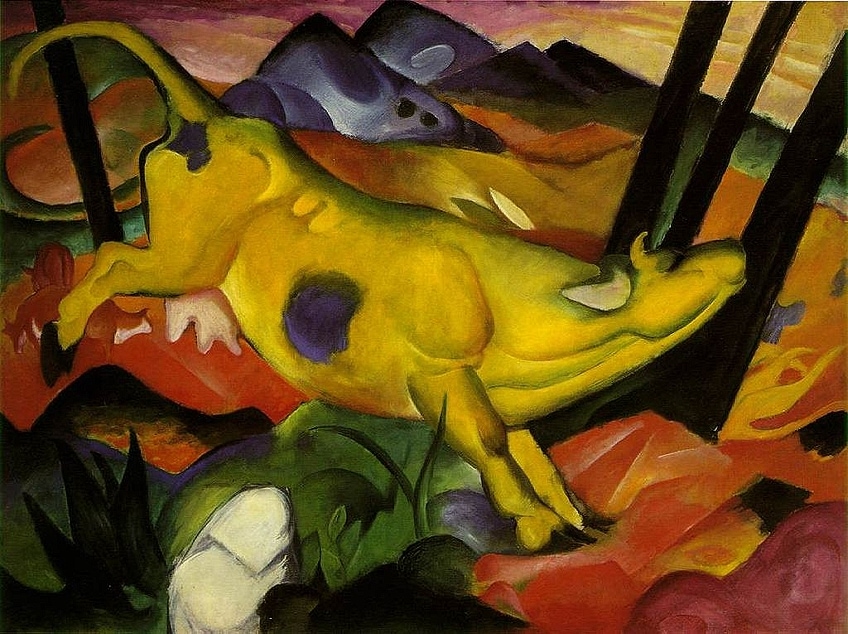
Worpswede paintings began in the Plein-air tradition of the French communes of Concarneau, Barbizon, and Pont-Aven, but swiftly evolved into a more modern Expressionism style. Later, Fritz Overbeck, Carl Vinnen, and Heinrich Vogeler joined the ensemble.
Paula Modersohn-Becker, a pioneering Expressionist who lived in Worpswede, was the most prominent Worpswede painter.
Other Notable Artists
The two great representatives of German Expressionist sculpture who were working in Germany in the run-up to World War I should be mentioned. The struggling Gothic-inspired Wilhelm Lehmbruck, known for his stone and bronze sculptures, and the wood craftsman Ernst Barlach are among them. The German Expressionism movement in Germany saw a strong comeback throughout the 1970s and 1980s as part of the broader neo-Expressionism movement.
Jorg Immendorff, Georg Baselitz, Rainer Fetting, Anselm Kiefer, and Markus Lupertz were among the most prominent German neo-Expressionists.
German Art Movements That Embraced Expressionism
German Expressionism paintings generated dramatic, captivating depictions of people and situations influenced by Edvard Munch, Vincent van Gogh, the Post-Impressionist colorist school led by Henri Matisse, and the emotional sculpting of Ernst Barlach.
Die Brücke, Der Blaue Reiter, and Die Neue Sachlichkeit were the movement’s three primary groups.
Die Brücke
Die Brücke was a Dresden-based Expressionist group created in 1905 by Ernst Ludwig Kirchner and Karl Schmidt-Rottluff. Emil Nolde, Erich Heckel, and Otto Mueller were also members. Die Brücke art, inspired by primitive art such as that of Paul Gauguin, presented radical societal viewpoints using contemporary urbanscapes, landscapes, and figure paintings.
Die Brücke’s art manifesto from 1906 said that the group’s goal was to obtain independence from the well-entrenched traditional German art styles.
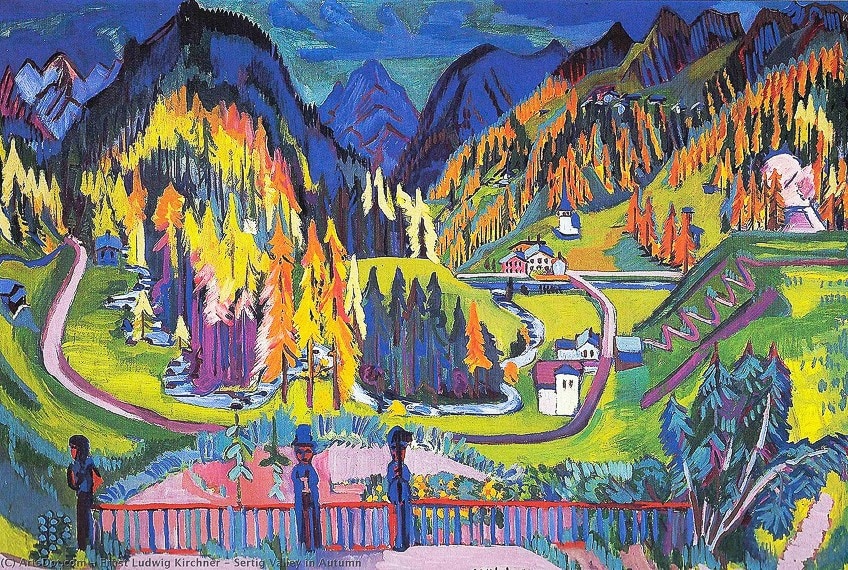
They achieved this by fusing traditional artwork with Oceanic and African elements, as well as Fauvist coloring, to produce an essentially contemporary aesthetic. Ernst Ludwig Kirchner’s Berlin Street Scene (1913) is an example of a Die Brücke-style painting.
Der Blaue Reiter
The Expressionist movement Der Blaue Reiter was founded in Munich, the center of the Neue Kunstler Vereiningung avant-garde movement. Franz Marc, a German painter, and Wassily Kandinsky, a Russian-born painter, were two of its most prominent artists.
Marc and Kandinsky broke away from the remainder of the Neue Kunstler Vereinigung in 1911 and began presenting their work under the name of Der Blaue Reiter. Gabriele Munter, Paul Klee, and August Macke were also members.
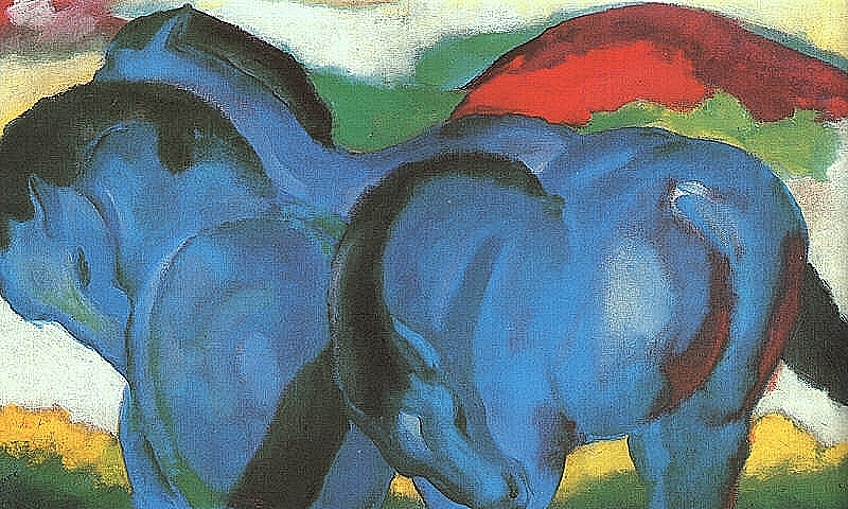
Though Marc and Kandinsky released their Almanach Der Blaue Reiter, a compilation of writings on art, in 1912, it stayed a loose group instead of a cohesive collective like Die Brucke. Their overall objective was to instill spiritual qualities in art by employing the use of color as a major strategy.
The meaning of the name Der Blaue Reiter is unknown.
Marc felt that animals were better than humans because of their purity, and the color blue may have had a special resonance for Kandinsky since he could hear colors as well as observe them – a rare condition called synesthesia. Der Blaue Reiter was destroyed during World War I when both Marc and Macke were murdered. Little Blue Horse (1912) by Franz Marc is an example of the group’s German Expressionism paintings.
Die Neue Sachlichkeit
Die Neue Sachlichkeit, a German Expressionism art group that was part of the 1920s postwar Realism style, was named after the show Neue Sachlichkeit, which was held in Mannheim in 1923. Its most prominent members were Expressionist artists George Grosz and Otto Dix, whose caustic and extremely critical depictions of Weimar Germany’s depravity and greed serve as a parody of the human experience worldwide.
Max Beckmann and Christian Schad, best known for their stunning self-portraits, were also members of the group.

Pimp with Prostitutes (1922) by Otto Dix is an important piece of art from Die Neue Sachlichkeit. Many German Expressionism artworks were branded as “degenerate art” in 1937 by Hitler, even though the traveling propaganda show featuring such pieces substantially broadened their appeal.
Notable German Expressionism Paintings
Expressionist artists frequently depicted their topics with whirling, wavering, and dramatic brushstrokes. These methods were intended to represent the artist’s emotional condition as a reaction to modern-day fears. Let us now look at a few notable German Expressionism paintings.
Hans Tietze and Erica Tietze-Conrat (1909) by Oskar Kokoschka
| Artist | Oskar Kokochka (1886 – 1980) |
| Date Completed | 1909 |
| Medium | Oil on canvas |
| Current Location | The Museum of Modern Art |
Erica and Hans Tietze, Viennese art scholars, commissioned Oskar Kokoschka to produce a wedding picture for their mantelpiece in 1909. The couple was staunch advocates of Viennese modern art. Erica Tietze said that Kokoschka sketched her and her spouse individually, which is conveyed by the couple’s feeling of detachment and their drastically different stances.
Kokoschka created the blurry surrounding environment with thin layers of color and imparted sizzling vitality to the arrangement by scraping into the canvas with his fingertips.
The vivid background and the figures’ intense motions show the pair as “contained egos so full of emotion,” as the painter once described them. Kokoschka, as in many of his works, concentrates on his subjects’ inner turmoil, here employing the couple’s anxious hands as a point of focus for their uneasiness. His representation portrays the artist’s perception of the couple’s mentality rather than their actual, realistic features. Kokoschka’s passionate depiction exemplifies the German Expressionist artists’ approach.
Kokoschka’s frenzied, depthless depictions of space are characterized by whirling, abstract hues that cover the backdrop.
Large Blue Horses (1911) by Franz Marc
| Artist | Franz Marc (1880 – 1916) |
| Date Completed | 1911 |
| Medium | Oil on canvas |
| Current Location | Walker Art Center, Minneapolis |
Franz Marc’s use of color to symbolize man’s connection with nature is well depicted in his 1911 painting Large Blue Horses. These horses are encased in a halo-like whirl of white. In the backdrop, there is an abstract landscape that also makes use of Franz Marc’s utilization of color symbolism. Horses would appear in numerous other works by the artist during this period, and it is apparent that this animal possessed many of the attributes that he required for his symbolic presentations.
Aside from that, he would employ a variety of other creatures in his works, including pigs and cows. He shared Pablo Picasso’s enthusiasm for animals’ comparative innocence in contrast to humans.

The painting features three huge horses grazing together in a herd, before a stylized backdrop of red hills, and has the artist’s characteristic palette of bold, primary colors. The animals take up the majority of the painting and are constructed entirely of flowing lines. When the Nazis assumed power, the artwork was removed from Europe because Marc was on their blacklist of ‘degenerate’ painters. The majority of Franz Marc’s artwork was brightly colored paintings of nature and wildlife.
He allocated different colors to distinct feelings and sensations. Blue was a manly color to him that also represented serenity and spiritual matters.
Blue-Black Fox (1911) by Franz Marc
| Artist | Franz Marc (1880 – 1916) |
| Date Completed | 1911 |
| Medium | Oil on canvas |
| Current Location | Von der Heydt Museum, Wuppertal |
The Franz Marc collection is characterized by pictures of diverse animals, each of which inspires a distinct mix of emotion and atmosphere. The fox may not be seen at first sight in this painting. The animals appear to be concealed, yet once viewed clearly, they are shattered, as if we are silently observing them through the pieces of cracked glass.
Blue-Black Fox, one of Marc’s most well-known artworks, is a beautiful example of a classic Marc painting, where he took actual, natural features and transformed them into abstract patterns in bright colors.
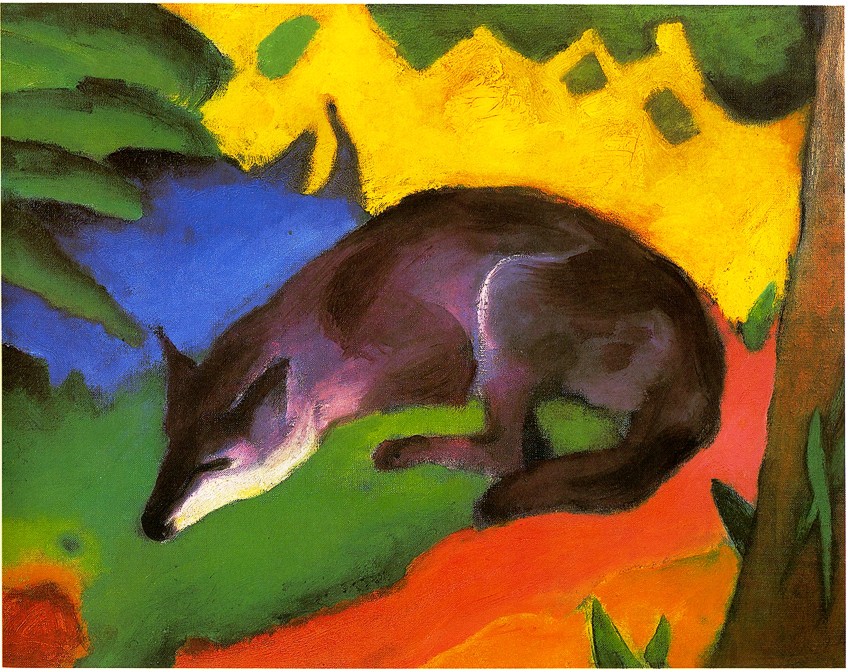
Colors, according to Marc’s creative perspective, communicated an emotional dialect, almost as if each color could hit a unique emotional note. Marc’s use of color was heavily influenced by his involvement with The Blue Riders, a collective of like-minded painters who sought spiritual truth through their artwork and put a high value on the metaphoric use of colors.
Creating animals like Blue-Black Fox symbolized a more innocent period for Franz Marc.
He attempted to express a statement about the natural environment, its relationship to humans, and their destructive influence on the earth through his various works depicting dogs, horses, and foxes. Marc chose animals as a subject because they provided an escape from the anguish and anxiety of modern life. Franz Marc painted his favorite animal images till the conclusion of his brief life.
Türkisches Café (1914) by August Macke
| Artist | August Macke |
| Date Completed | 1914 |
| Medium | Oil on wood |
| Current Location | Lenbachhaus, Munich |
During a trip to Tunis in the spring of 1914, August Macke created Turkisches Cafe, which signaled a new path in his work. On this tour, he was joined by two more artistic spirits, Louis Moilliet and Paul Klee. It is possible that Turkisches Cafe was produced in Germany after the painter returned from his travels. During his journey, he created a lot of drawings as well as watercolor works while discovering more about this intriguing and unique area.
After having returned to the comforts of his own workspace, Macke would utilize these sketches as the foundation for a set of works that he made in Bonn.
He could get whatever he needed there, and painting would be easier and more pleasant. The artist’s memories of Tunis were still fresh in his thoughts, and those feelings could be channeled in works like this. Numerous features of this North African location would influence modifications in the artist’s oeuvre, arguably the most essential being the clear, ample light, as well as the vibrant colors that saturate this area’s culture through buildings, clothes, and food.
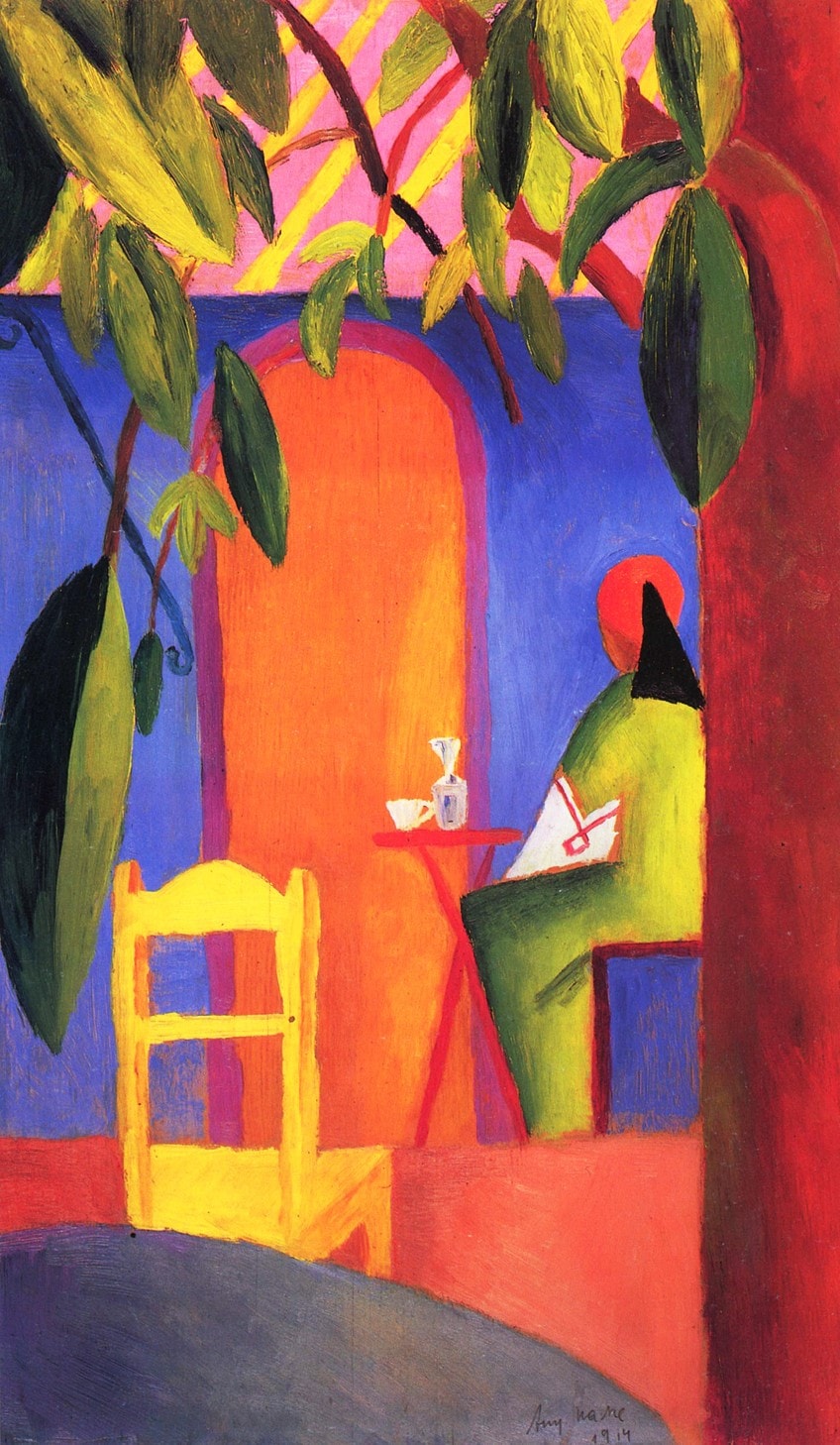
Macke would give Bernhard Koehler his two reproductions of this cafe as thanks for his funding aid with the trip. Some have stated that this painting was inspired by a trip to Café des Nattes in Sidi-Bou-Said. One can observe how the artist simplified a complicated subject into basic blocks of color while yet allowing the spectator to grasp the composition’s many aspects.
This was the path his art was taking at the time, inspired in part by the works of Robert Delaunay. Unfortunately, Macke died not long after these works were completed.
Portrait of a Man (1919) by Erich Heckel
| Artist | Erich Heckel (1883 – 1970) |
| Date Completed | 1919 |
| Medium | Woodcut |
| Current Location | The Museum of Modern Art, New York |
One year after Germany’s loss in World War I, this emaciated self-portrait depicts tiredness that is both psychological and emotional, individual and societal. Heckel had been a founder member of Die Brücke, one of the numerous artist organizations that established the contemporary style of Expressionism, whose members employed deformed forms and color to enhance the emotional effect of their topics before participating in the war.
Die Brücke painters restored the woodcut method, which has a long legacy in Germany dating back to the 14th century, in order to construct a connection between the old and the new, as the group’s name indicates.
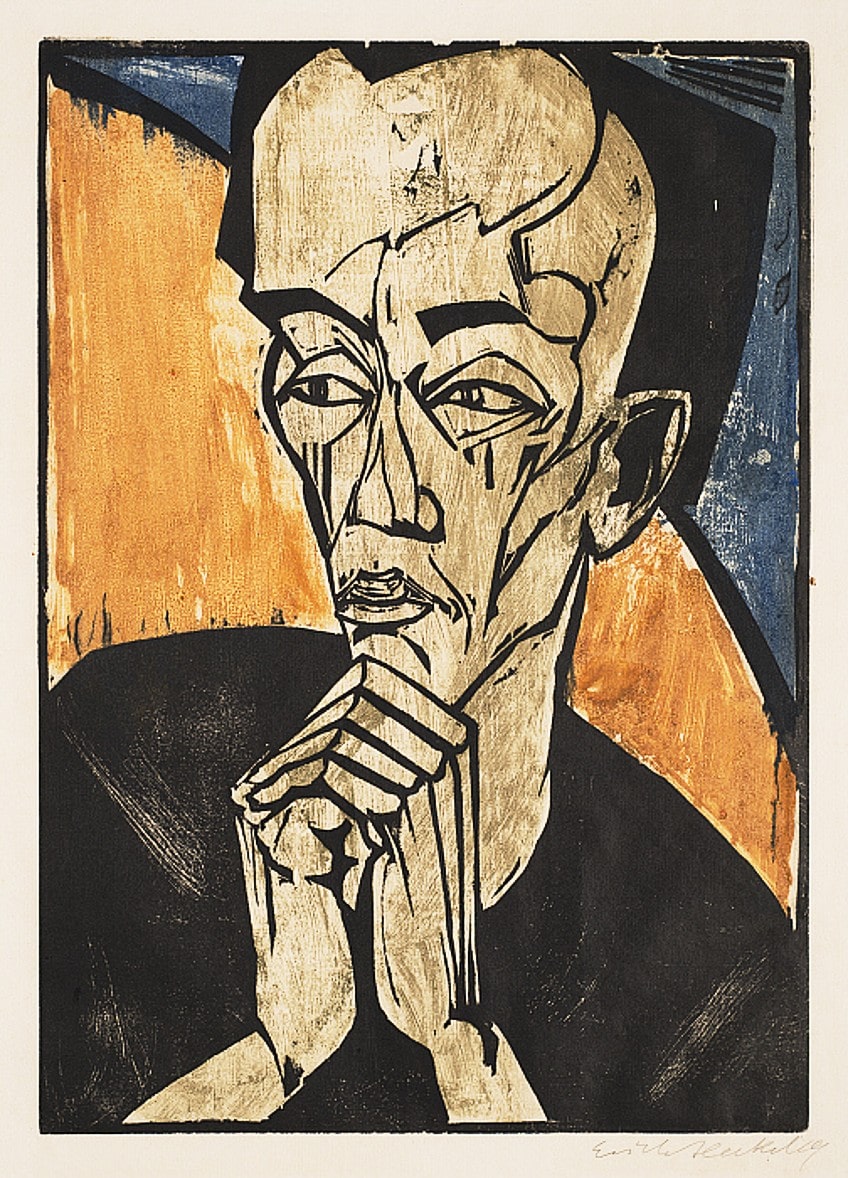
Heckel and his associates explored the medium’s ability to create strong, flat shapes and rough-hewn textures. This method may be observed in Portrait of a Man in the shapeless stretches of hair and clothing, the harsh lines of the head, and the rough outlines that form the face. The clasped hands are reminiscent of those seen in Middle-Ages woodcuts of Believers in prayer, a religious meaning underlined by the portrait’s icon-like shape and the stained-glass appearance of black lines around dazzling expanses of yellow, green, and blue.
However, while the saints and faithful turned to the heavens for insight or pardon, Heckel casts a dejected glance to the left.
Seated Girl (1920) by Ernst Ludwig Kirchner
| Artist | Ernst Ludwig Kirchner (1880 – 1938) |
| Date Completed | 1920 |
| Medium | Oil on canvas |
| Current Location | Minneapolis Institute of Art |
Lina Franziska Fehrmann modeled for several works associated with the Die Brücke group, which was significant in the overall emergence of the German Expressionists. She and many of her siblings dressed as adolescent models on various occasions. They were intertwined in the activity of this forward-thinking art movement that served to attract awareness to modern Expressionism in the early 20th century. She began modeling at 10 years of age and continued until she was in her 30s.
She is still considered an enigma in the genre, having appeared in numerous significant works but with the world left knowing very little about her.
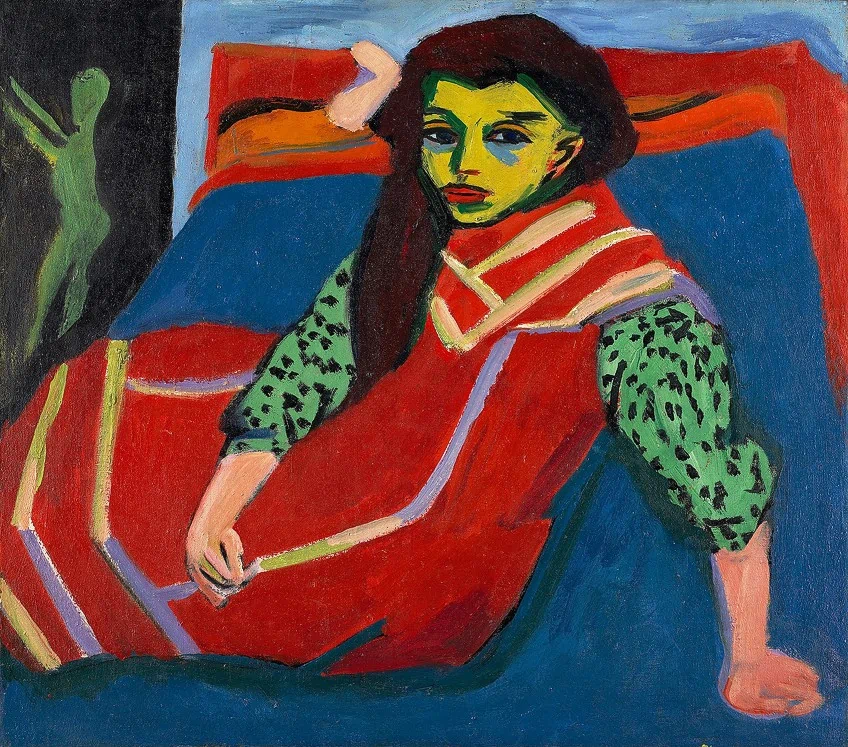
The model in Seated Girl is pictured with bright red lips, appealing eyes, and gorgeous attire. Her sexuality was obvious and highlighted, but she was clearly too young to be depicted in this manner. A cursory examination of the two paintings, Seated Girl and Franzi in Front of Carved Chair, reveals that they are certainly the same subject.
The facial structure, even the artist’s color scheme, with accents of green over her face, match up.
The stance in this artwork does alter significantly, as she leans back on a bed. The artwork is presently housed at the Minneapolis Institute of Arts, but if you plan on going to see it, be sure to confirm ahead of time because many artworks can be borrowed or changed over time.
The Widow I (1921) by Käthe Kollwitz
| Artist | Käthe Kollwitz (1867 – 1945) |
| Date Completed | 1921 |
| Medium | Woodcut |
| Current Location | Brooklyn Museum, Brooklyn |
Käthe Kollwitz started working on Krieg in 1919 as a reaction to the catastrophes suffered during the “unutterably awful years” of World War I and its repercussions. The portfolio’s seven artworks depict the anguish of people left behind, including parents, spouses, and infants. Kollwitz had been struggling to find the right way to express herself until she viewed an exhibit in 1920 of Ernst Barlach’s woodcuts.
Kollwitz dramatically reduced the compositions by reworking each image through as many as eight preliminary sketches and phases.
The large-format, austere woodcuts depict women who have been left to confront their sorrow and concerns alone. The troops are only depicted in one picture. In it, the artist’s son, Peter, stands next to Death, leading the army in an exuberant parade to battle. Only two months later, Peter died in combat. Kollwitz desired that these pieces be widely seen.
She crafted globally understood images of the real sacrifices expected in exchange for notions of honor and grandeur by removing allusions to a specific period or place.
Fish Magic (1925) by Paul Klee
| Artist | Paul Klee (1879 – 1940) |
| Date Completed | 1925 |
| Medium | Oil and watercolor on canvas |
| Current Location | Philadelphia Museum of Art, Philadelphia |
Fish Magic, one of Klee’s most renowned works, blends a delightful landscape with brilliant color. A Paul Klee artwork elicits a range of feelings in the observer, and the Fish Magic artwork is no exception. Klee finished this picture during his peak years as a painter before succumbing to Scleroderma, aged 60.
Fish Magic is one of the paintings that immortalizes the artist’s inventiveness in merging many elements to achieve something exceptional.
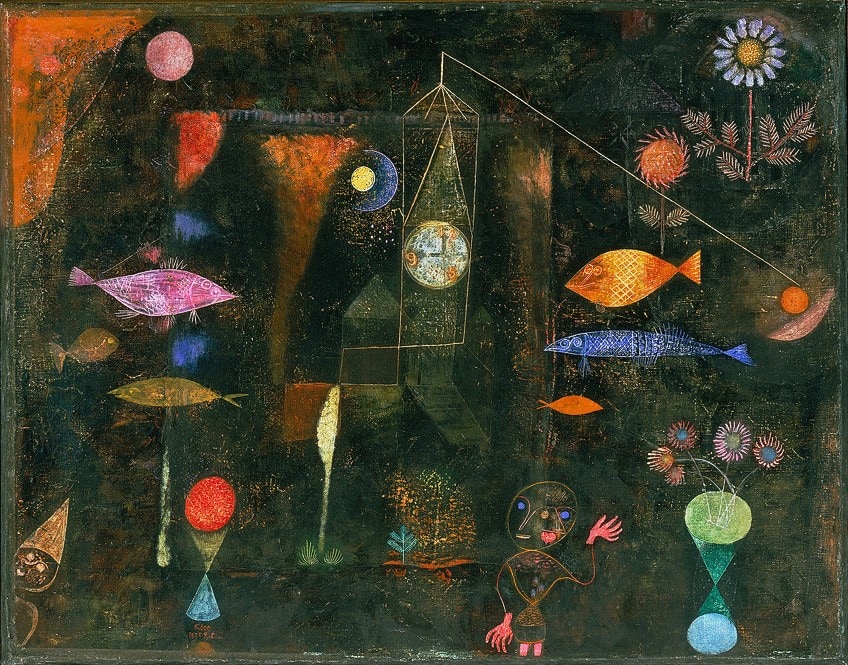
Both oil and watercolor were used to make Fish Magic on panel, and it blends components from the sea, the land, and the universe. Anyone looking at the artist’s paintings for the first time could confuse them for a preschool watercolor work.
However, when you look closely at the pieces and see how they work together to convey a narrative, you realize Klee was an artistic prodigy.
Following its completion, many duplicates of the Fish Magic artwork were created and are now being offered online to eager consumers. Klee is well-known for numerous artistic pieces that demonstrate his ability as a modern artist. Klee creates a scene with birds and what seem to be fish connected to a machine.
Breakfast of the Birds (1934) by Gabriele Münter
| Artist | Gabriele Münter (1877 – 1962) |
| Date Completed | 1934 |
| Medium | Oil on board |
| Current Location | National Museum of Women in the Arts, Washington DC |
Breakfast of the Birds is a perfect example of Gabriele Münter’s Expressionist technique, with thick, quick brushstrokes, heavy, black contours, reduced shapes, and compacted space. A lady sits inside at a table with a supper in the picture. Through the window, we enjoy her vision of snow-covered trees and a flock of birds. The thick curtains that border the window provide a sense of coziness or confinement, depending on your point of view. This interior has been regarded as representing seclusion and peace, as well as imprisonment and psychological isolation.
Some historians believe the woman depicted here, with her back to the observer, is the painter herself. Münter and other painters created Der Blaue Reite in 1911.
Münter’s work is frequently connected with the German Expressionism approach adopted by individuals of this movement, but she had a level of self and originality that she ardently committed to her bright paintings. Despite the limits placed on her as a rebellious painter during the Nazi era, Münter continued to make portraits, still lifes, landscapes, and interior settings such as this artwork.
German Expressionism paintings were part of a group of German art movements that originated in the early 20th century and were distinguished by an emphasis on feeling and thoughts as sources of inspiration. The movement’s foundation stood in sharp contrast to previous movements that emphasized more authentic portrayals of truth and the natural world. German Expressionism art also included the cultural, social, and political ideas of the time’s newer generations. German Expressionism art was an attitude of thinking, not merely a style.
Take a look at our German Expressionism webstory here!
Frequently Asked Questions
What Were German Expressionism Paintings?
The main media of the style was painting, and the produced pieces exemplify the concepts of the German Expressionists. Architecture, sculpture, and film were all prominent. It extended beyond the visual arts to numerous sectors and fields, notably music, literature, and theater. German Expressionism art has continued to thrive to this day, and even though the genre’s few important years have long passed, it is still considered an impactful movement for creators and admirers alike.
In Which Country Did the Expressionist Movement Originate?
From immediately after the beginning of the century until the early 1920s, a variety of critical topics and genres emerged, several of which express genuinely humanist issues. Groups of Expressionist painters arose concurrently in several locations around Germany in response to widespread concerns about humanity’s increasingly discordant relationship with the world, as well as a sense of a loss of purity and spirituality. As a result of their clashes with early 20th city life, Expressionist painters developed a powerful means of social critique in their expressive portrayals and use of vibrant colors.
What Are the German Expressionism Characteristics and Themes?
The nude body and its capacity to express primitive feelings; psychologically intense portraiture; and, most importantly, the necessity to address the horrific experiences of World War I and its repercussions are among these. German cities saw an expansion in scale and density of population after German unification as a byproduct of an extraordinarily fast phase of industrialization in the 19th century. The Expressionists had mixed feelings toward the contemporary metropolis. On the one extreme, they understood the urban lifestyle’s degrading and dehumanizing impacts. Simultaneously, they appreciated the energy and vigor of the city’s frantic pace and many attractions.
Jordan Anthony is a Cape Town-based film photographer, curator, and arts writer. She holds a Bachelor of Art in Fine Arts from the University of the Witwatersrand, Johannesburg, where she explored themes like healing, identity, dreams, and intuitive creation in her Contemporary art practice. Jordan has collaborated with various local art institutions, including the KZNSA Gallery in Durban, the Turbine Art Fair, and the Wits Art Museum. Her photography focuses on abstract color manipulations, portraiture, candid shots, and urban landscapes. She’s intrigued by philosophy, memory, and esotericism, drawing inspiration from Surrealism, Fluxus, and ancient civilizations, as well as childhood influences and found objects. Jordan is working for artfilemagazine since 2022 and writes blog posts about art history and photography.
Learn more about Jordan Anthony and about us.
Cite this Article
Jordan, Anthony, “German Expressionism – Discover Some Traditional German Art.” artfilemagazine – Your Online Art Source. August 24, 2022. URL: https://artfilemagazine.com/german-expressionism/
Anthony, J. (2022, 24 August). German Expressionism – Discover Some Traditional German Art. artfilemagazine – Your Online Art Source. https://artfilemagazine.com/german-expressionism/
Anthony, Jordan. “German Expressionism – Discover Some Traditional German Art.” artfilemagazine – Your Online Art Source, August 24, 2022. https://artfilemagazine.com/german-expressionism/.



